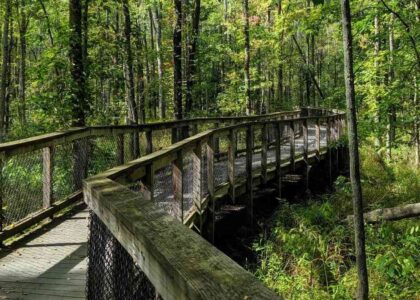Welcome to the site of the 1775 Battle of Great Bridge, a pivotal moment in American history that unfolded right here in what is now Chesapeake, Virginia. Imagine standing on this very ground in December of 1775, when tensions between the American colonists and the British crown were reaching their peak. This location, which now features the Great Bridge Battlefield & Waterways Museum, was once a strategic point of contention during the American Revolutionary War.
The story of Great Bridge begins with its geographical significance. In the 1700s, it was part of a crucial road connecting Norfolk, Virginia, to the Carolinas. This road was more than just a path through the swampy terrain; it was a vital artery for trade and military movement, built with timbers to form causeways and corduroy roads that kept travelers above the marshy ground. It linked two critical watersheds: the Chesapeake Bay and the Albemarle Sound, making it a strategic asset for both the British and the Patriots.
In the autumn of 1775, the Royal Governor of Virginia, Lord Dunmore, found himself in a precarious position. Fleeing from the colonial capital of Williamsburg, he took refuge in Norfolk and sought to rally Loyalist support. Yet, the Patriots were closing in, and they knew that controlling the Great Bridge was essential to cutting off any British reinforcements from the south. Dunmore ordered the construction of Fort Murray, a stockade positioned just north of the bridge, to secure the British hold on the area.
The tension culminated on December 9, 1775, when Dunmore, emboldened by reinforcements from the British 14th Regiment, ordered an attack across the bridge. The British forces, including 60 grenadiers, moved out under the cover of early morning darkness, setting fires as they advanced to create a smokescreen. However, the Patriots were ready. They had constructed defensive earthworks and positioned riflemen to cover the narrow causeway.
As the British troops advanced, they found themselves caught in a deadly crossfire. The narrow causeway offered no cover, and the British forces were decimated in the ensuing battle. Captain Charles Fordyce, leading the charge, fell with multiple bullet wounds, and within half an hour, the battle was over. British casualties were significant, with estimates ranging from 60 to 100, while the American forces suffered only one minor injury.
This brief but decisive battle forced Dunmore to evacuate Norfolk, effectively ending British rule in Virginia. It cleared the path for Virginia to pursue independence and support the growing Revolutionary War effort unhindered. The Battle of Great Bridge is a testament to the strategic importance of this location and the bravery of those who fought here.
Today, the Great Bridge Battlefield & Waterways Museum stands as a tribute to this critical moment in history. Visitors can explore interpretive trails, monuments, and historic markers that bring the past to life. The museum itself houses artifacts and exhibits that tell the story of the battle and the area’s significance in the broader context of the American Revolution.
As you walk these grounds or drive past on the Chesapeake Expressway, remember the courage and determination that once defined this place. The legacy of the Battle of Great Bridge is one of resilience and the enduring quest for freedom—a story that continues to inspire us today.




